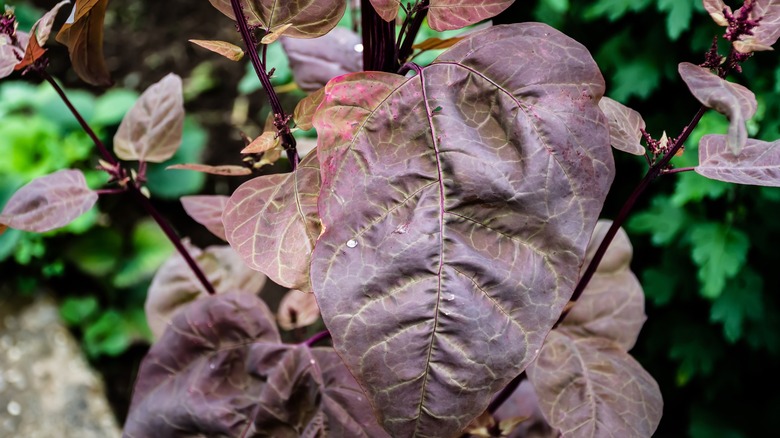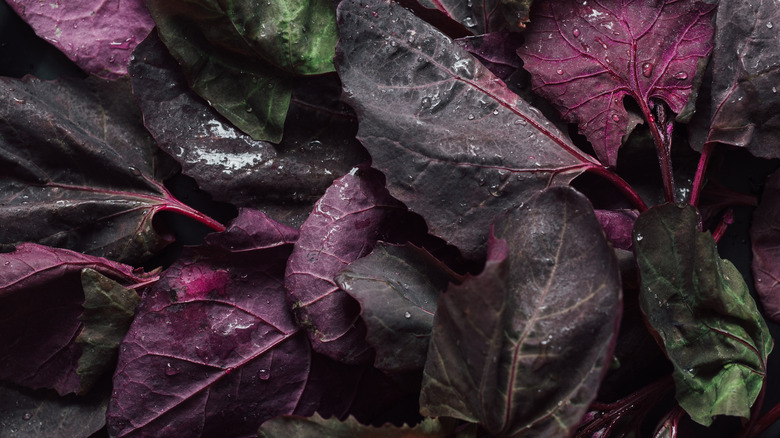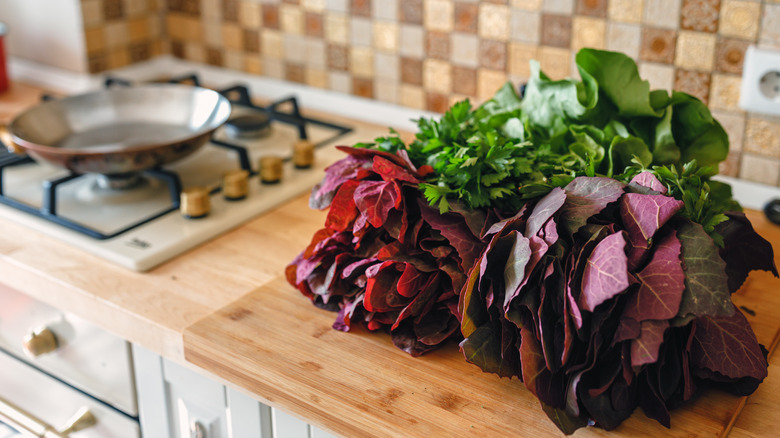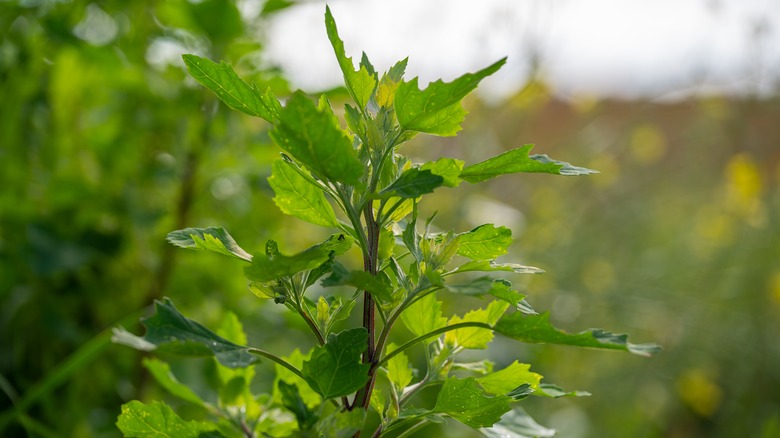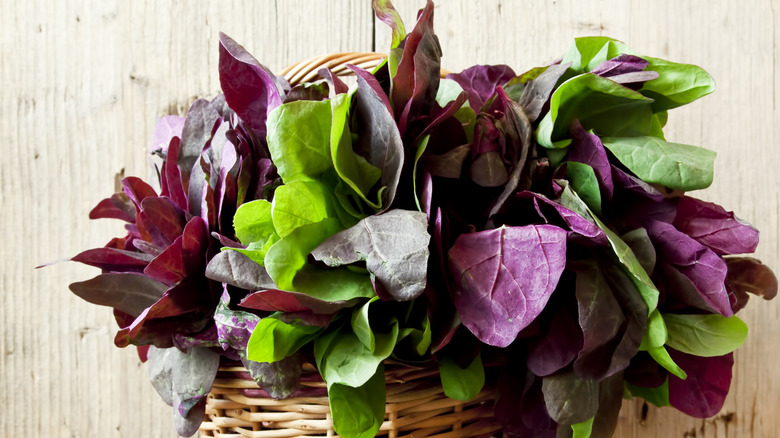What Is Orach And Is It Naturally Salty?
To many, the name orach may seem obscure, but chances are you've passed by this plant in a garden. Boasting bright red, yellow, and green leaves, the slender plant can reach several feet in height. Its leaves, which look a bit like lettuce, can reach the size of a hand, establishing orach as a popular ornamental choice. However, it's more than just the looks — the plant also has a long history of human consumption.
This cousin of spinach can grow in rocky soil and survive cold conditions. Produced for thousands of years, it was once a staple of European diets. And with a tantalizing saltiness and a less bitter flavor than its leafy counterparts, it's not hard to understand its ubiquity. Plus, it's incredibly flexible to cook with — easily integrated into everything from salads and soups to pasta dishes and more. Let's dive into what this ancient cultivated vegetable is all about.
What is orach?
Orach, also called mountain spinach, garden orache, or saltbush, is a hearty vegetable in the Amaranth family. Once one of the most widely-cultivated vegetables in Europe, the plant is a close relative to spinach as well as a cousin to beets, epazote, and quinoa. While many leafy greens only grow in the summer, orach can withstand both a frost and warmer temperatures. A quick grower, it can be planted several times during a season and still yield a harvest. Gardeners love the plant's bright colors, which range from green to yellow and red. There is not a large taste variability amongst the types, so they can be used in similar recipes.
Orach is widespread throughout Europe, Northern Africa, the Middle East, and Northeast Asia and thrives in North America as well. Noted well before even Ancient Greek times, orach is believed to be one of the oldest cultivated vegetables. It remained popular for centuries — prevalent as one of Europe's most commonly consumed plants up to the 18th century. However, for unknown reasons, spinach overtook the plant in popularity and forced orach into obscurity. Now, especially in the hands of gardeners, it's experiencing a resurgence.
What does orach taste like?
Orach has a green and leafy flavor similar to chard, spinach, and other plants in the Amaranth family. While wild varieties of orach have an unappetizing bitter quality, cultivated orach tastes even milder than spinach. Like other leafy greens, orach releases a fair bit of moisture when cooked — a quality that can be used advantageously with colorful varieties as a colorant. In accordance with its saltbush moniker, orach's taste can take on a saltier, more mineral-like quality. This is due to the plant's propensity for coastal and rocky soil; it transmits its surroundings through its flavor.
Orach's texture depends on the time of harvest. Young leaves are tender — similar to lettuce and suitable for a salad. On the other hand, older ones become rigid, like kale, necessitating some heat application. The plant's seeds are also edible; while not highly pronounced in flavor, they're easy to integrate as ground flour into varying applications.
Orach's culinary uses
Orach can be used in various applications — interchangeable with spinach or chard in their respective recipes. With their pleasant saltiness, young orach leaves make for a great salad component, highlighted by a simple olive oil dressing. The flavor melds especially well with nuts, like walnuts or pecans.
Sautéed orach makes for a great addition to a quiche, baked egg dish, or an omelette. And when lunchtime rolls around, you can add the cooked leaves to a soup. Orach's pleasant flavor is highly malleable, perfect for counterbalancing more robust companions. In France, it's prepared in a pan alongside sour sorrels, or Greeks stuff it into spanakopita with sardines.
Especially when using colored orach leaves, integrate them into dishes for a dash of appetizing color. When cooked, the hue of the plant itself will fade, but it'll impart its essence into the water. Consider applications like turning rice into a bright red in a pilaf or producing vivid green, red, or yellow varieties of pasta.
Orach's nutritional qualities
Like its much-lauded cousin plants spinach and quinoa, orach packs in some noteworthy nutritional content. It contains an extensive array of vitamins, minerals, and fibers, all beneficial to health. Its bright color arises from anthocyanins, a type of flavonoid that's shown to regulate inflammation and obesity and prevent cardiovascular issues.
According to Canadian Living, orach also promotes heart health by serving a sizable portion of potassium, with 100 grams containing up to a third of the mineral's daily requirement (via National Institutes of Health). Its noteworthy fiber content also keeps digestion and cholesterol levels maintained. However, orach's most packed-in vitamin is calcium. A single serving delivers well over a daily requirement for the mineral, which maintains strong bones and teeth.
Orach is an excellent vegetable to eat for disease prevention. It contains magnesium, zinc, and especially vitamin C, which are all vital for fighting against bacteria and viruses. The plant contains them in spades, so a batch will do well to ease an imminent cold, per Woodside Farms.
How to procure and store orach
The best way to obtain orach is to grow your own. Not only easy to maintain, but the vegetable will start to produce delicious young leaves in only a few months. Plus, red and yellow varieties make for a superb ornamental plant — brightly colored and reaching up to six feet in height. Seeds are available from local gardening stores or online purveyors, such as Sow True Seed. Orach is typically planted in early spring for a summer harvest.
For those without a garden or green thumb, head to the local farmer's market to obtain a bunch. Search for leaves that aren't wilted, and give off a pleasant reflective quality. Store orach in a manner similar to spinach — away from moisture in a sealed bag. If rewarded with a large amount of the vegetable, blanch the leaves and then freeze them for later use. However, chances are there won't often be much orach left over after a haul. With its ease of use and pleasantly salty flavor, the vegetable begs for another bite.

